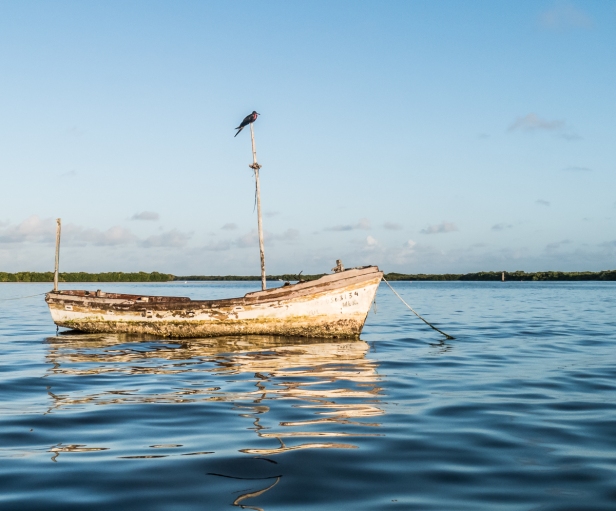
20 Dec 2016. We’ve just pulled away from shore and are heading under a low bridge when I see this young snowy egret hiding beneath it.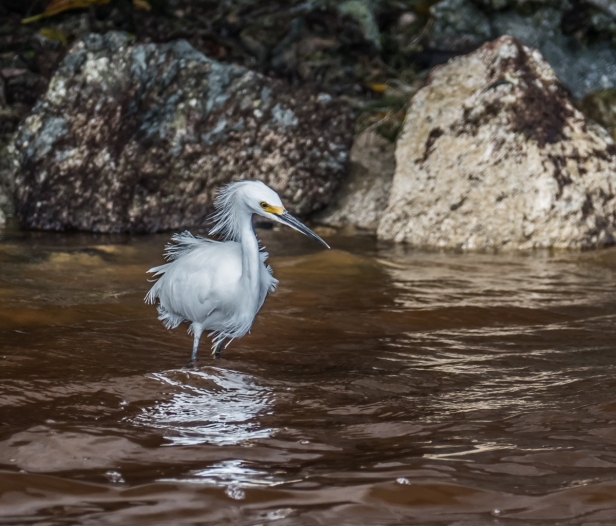
The boat captain slows down for me to photograph it, and then we are on our way speeding across the waters of the estuary. We are near the town of Celestún on the north-west coast of the Yucatan Peninsula facing the Gulf of Mexico and we’re going to see the flamingoes. Birds fly along side the boat, travelling at the same speed.
We see small groups of the distinctive pink and red flamingoes far off near the shore,
but we are headed for a larger group feeding in the shallows.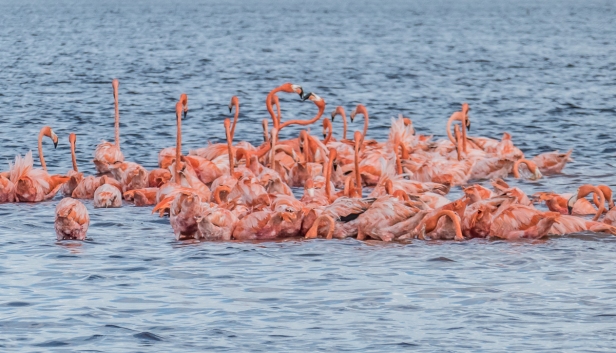
As you can see from Don’s video, there are hundreds of them, squawking like ducks, tangling with each other, dipping their heads over and over into the water to feed on the minute red shrimp that colour their entire bodies and all their feathers except the black wing tips.
We see dozens more flying in to join the flock.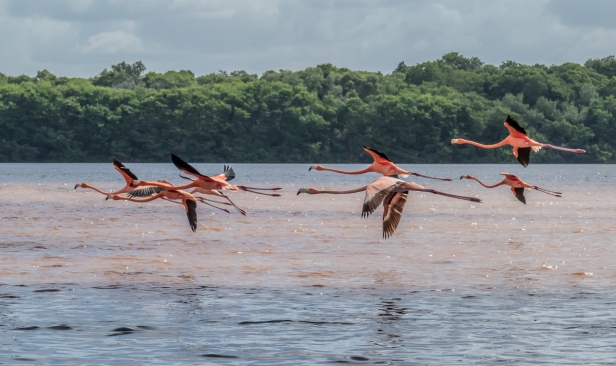

I’m excited. I can’t remember when I was last so excited. And happy. I’m trying to take it all in, and of course in looking in one direction I’m missing what’s going on in another. There are six of us in the boat and we alert each other as more birds arrive or depart. These three, looking as if they’re running across the water, are about to land.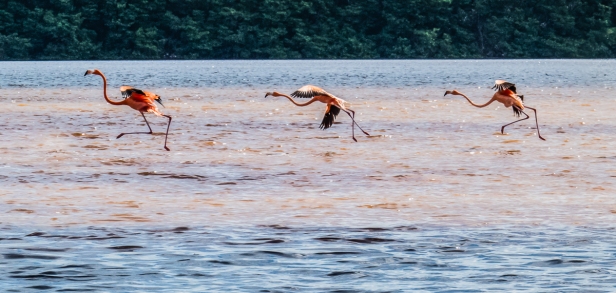
The Reserva de la Biosfera Ría Celestún (Celestún Estuary Biosphere Reserve) is a large coastal wetland reserve and wildlife refuge covering 146,000 acres. It is a unique eco-system created by the combination of salt water from the Gulf of Mexico and fresh water from the estuary. This combination makes it a perfect habitat for flamingoes and waterfowl. It is home to over three hundred species of birds.
After watching the flamingoes we slowly cruise the shore for a while spotting cormorants, ibis, herons, egrets, and pelicans.
We turn into the mangrove swamps where it is possible to see the red colouration in the water from the shrimp,
and we stop briefly at a natural spring deeper in the tangled mangroves.
All too soon it is over and we’re headed back to Celestún where we are delivered to a beach restaurant. We are told we have two and a half hours for lunch and the beach. Don and I are disappointed. We had been promised two hours or more on the water exploring the mangrove swamps and watching the flamingoes and other birds. We’ve just come from six weeks at the beach so don’t feel in need of extra beach time. It is what it is. We walk along this beach on the Gulf of Mexico, so different from the white sand beaches of the Mayan Riviera on the Caribbean side of the Yucatan Peninsula. This beach has rougher waves, and is thick with shells.
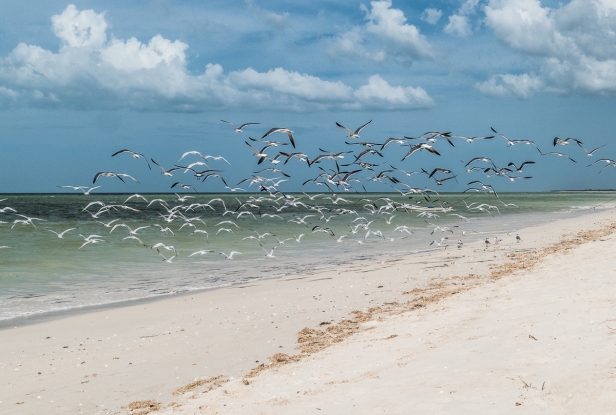
Huge red starfish are washed in on the waves. They are the same starfish we’ve seen in great numbers off the coast of Cozumel, the same ones that feel like hard plastic. There’s a man on the beach gutting a couple of them. He cuts a star shape out of the underside and cleans out the interior. As best I can understand they are then used as wall decorations.
We eat lunch. Afterwards, we spread the sarong under a couple of young palm trees and surrender to the moment. Magnificent frigates fly overhead. Magnificent is their official name. It is also an apt descriptor.
28 Dec 2016. We take a bus from Valladolid to Tizimin, then a taxi from Tizimin to Rio Lagartos, arriving mid afternoon. 
Our room is not ready so we sit on the balcony of the restaurant watching the fishing boats on the water and the humming birds at the feeders hanging close by. They are tiny jewels and defiant warriors, fiercely guarding their territory.
Later, after checking into our room, we walk down by the water at sunset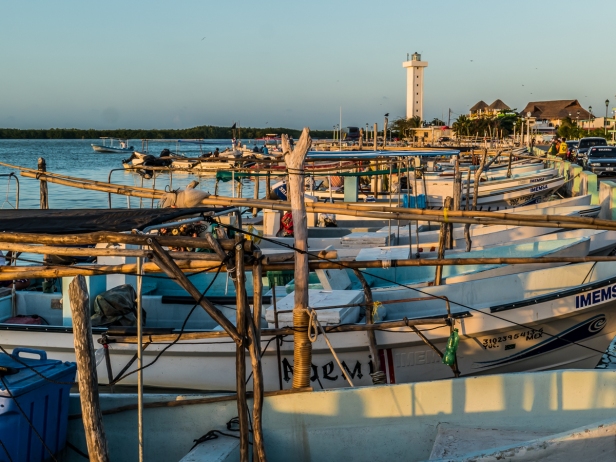
and watch the pelicans catching dinner. In great contrast to the delicate hummingbirds, pelicans are large and ungainly. They can be quite majestic in flight, but when diving for fish, filling their gullets, fighting the waves, they can be graceless and comical. The brazen seagulls constantly land on the pelicans hoping for a free meal.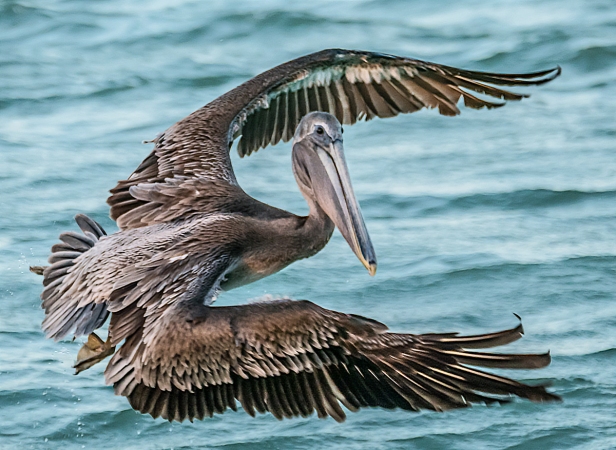

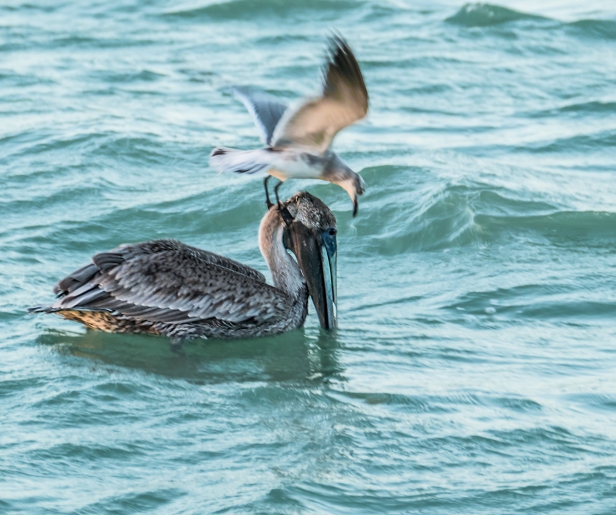
Rio Lagartos means Alligator River and was named by the Spanish who mistook an estuary for a river, and crocodiles for alligators. The town of Rio Lagartos is actually situated on Ria Lagartos, the Lagartos Estuary.
Reserva de la Biosfera Ría Lagartos (Ria Lagartos Biosphere Reserve) is about three hundred kilometres east of Celestún along the north coast of the Yucatan Peninsula. The reserve covers 150,000 acres of forest, dunes, mangroves, estuary, and beaches. Within the reserve 395 species of resident and migratory birds have been identified, along with over 250 species of mammals, amphibians, reptiles, and fish. There are four small towns within the reserve: El Cuyo, Las Coloradas, San Felipe, and Rio Lagartos.
The Ria Lagartos Biosphere Reserve is the home of more than 43,000 flamingoes. They collect there in the summer for breeding and nesting and then spread out along the coast to Celestún and elsewhere during the winter. As with the estuary at Celestún, in the Lagartos estuary there is a mix of salt and fresh water creating the perfect habitat for the brine shrimp that the flamingoes feed on.
It is from the town Rio Lagartos that we have the kind of experience we’d been hoping for in Celestún.
We’re up at six, and by half past have had a cup of tea and are waiting on the dock for Francisco who is to be our guide for the day. He soon arrives and by 6.45 we are underway. We don’t need to go far. A short distance away we see a group of flamingoes and Francisco heads towards them. It is barely past sunrise and the world is honeyed with golden light. And there they are in front of us, not more than twenty feet away, thirty or forty flamingoes feeding in the shallows.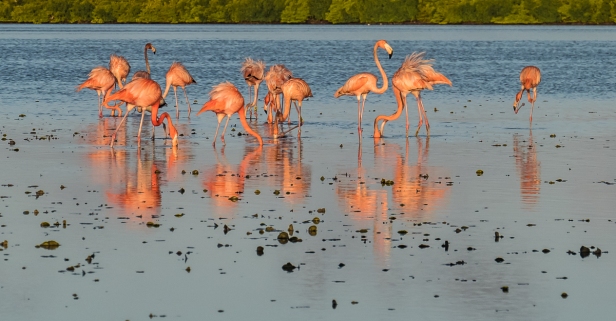
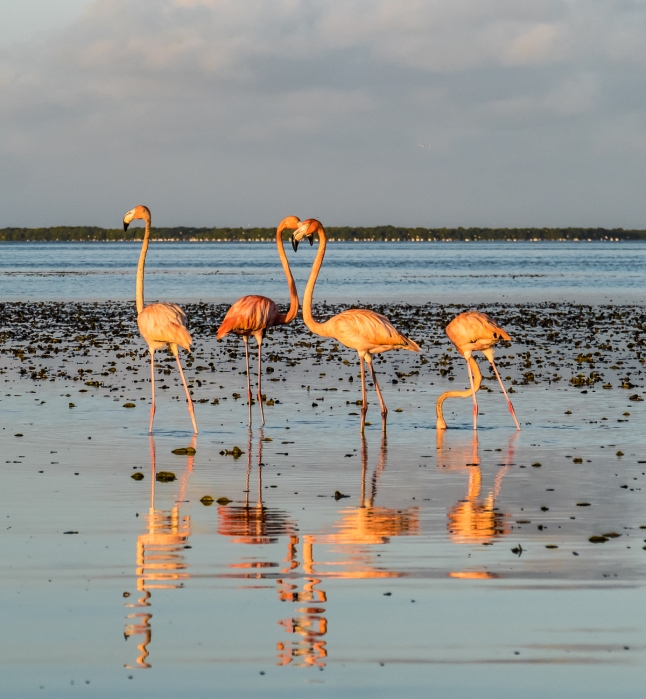

There is a pale young one. The older they get, the more they eat, the redder they become.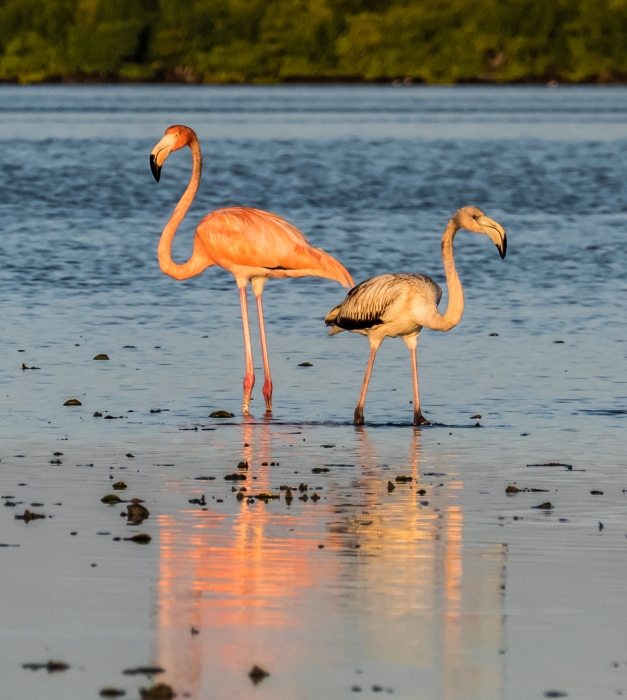
There is no rush, there is time to revel in the experience, but eventually Francisco fires up the engine and we head slowly in the other direction, back past the dock, past a convention of pelicans,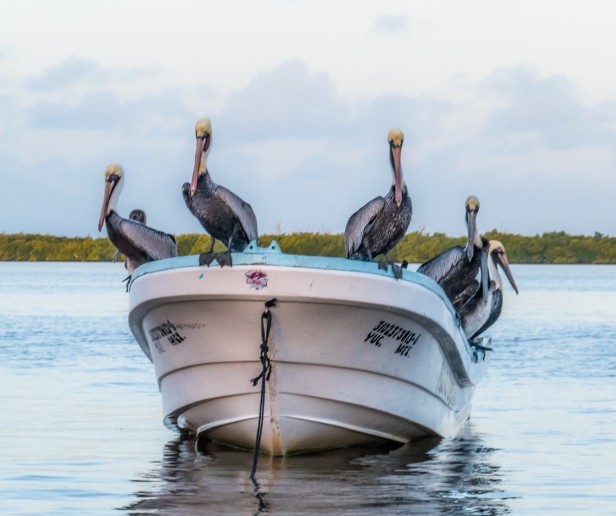
past a young frigate,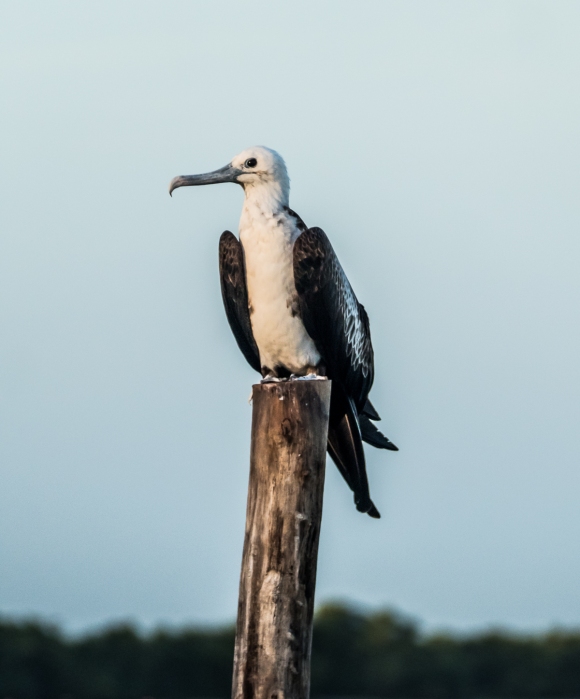
and on deeper into the estuary. Francisco is expert a spotting wildlife. He maneuvers gently up to the shallows where the birds are feeding,

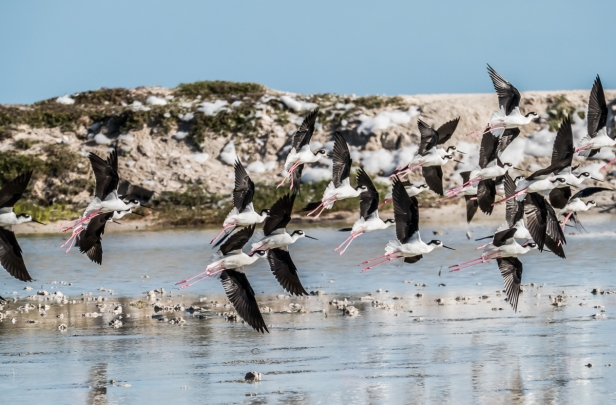
and slowly drifts by ibises, their long beaks plunged into the water. We see a raccoon scurrying by in the tangle of mangroves, and we sidle quietly up to a sand bar and watch white pelicans from Canada, and great flocks of royal terns and laughing gulls. We see many cormorants, several species of herons, and an iguana clinging to a mangrove root bathing in the early morning sun. We cruise slowly by a double-crested cormorant,
a black hawk eating a fish breakfast high up on a dead branch,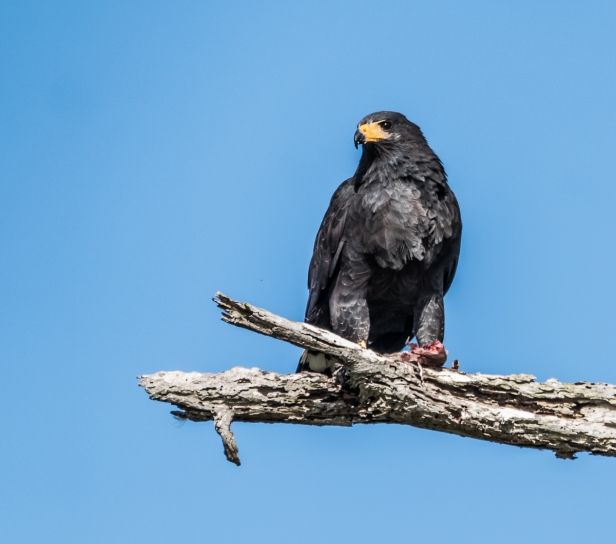
a great blue heron,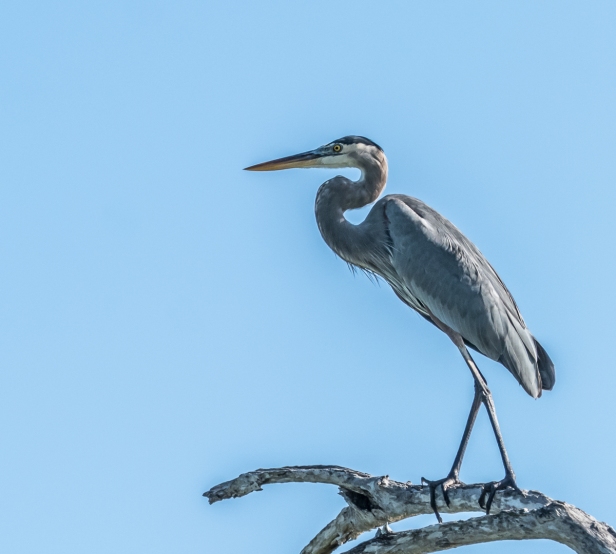
and a pelican out on a limb.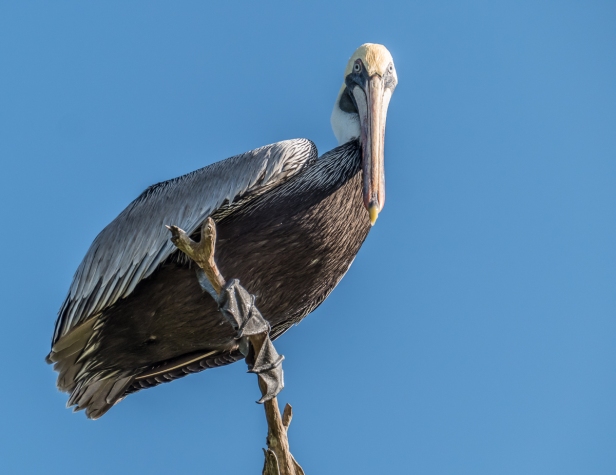
There are a couple of dozen pelicans all in a row on a log, more flamingoes,
and in shallow water a crocodile.
Francisco is always on the look out, and misses nothing. At least twice we are moving at speed and suddenly, unexpectedly, the boat slows, he reverses and points out a green heron, barely visible in the undergrowth,
and later a stork feeding in the shallows of a backwater, barely visible behind the false shore. But our guide catches it, reverses the boat and slows almost to a stop at the entrance to the backwater so we can see it. Although a different species we recognize its similarity to the Jabiru, a stork native to Australasia.
And then we are moving fast for several minutes, heading further along the broad estuary towards Las Coloradas. Las Colorados is a village on the estuary about twenty kilometres from Rio Lagartos. More importantly Las Coloradas is salt ponds, huge ponds of pink water that go on into the distance as far as we can see. We clamber out of the boat and walk along the berm that forms the wall of the nearest pond. The water, rippling softly in the breeze is pink from the brine shrimp.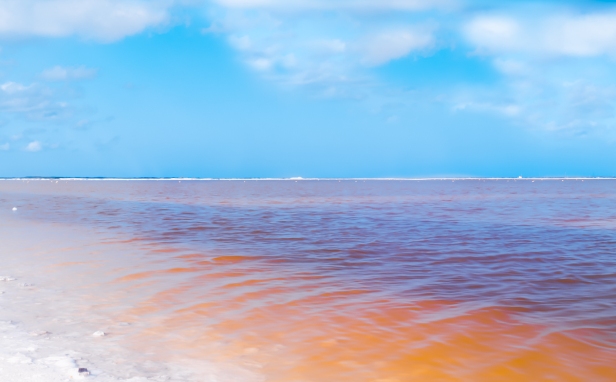
In the distance in some of the ponds, flamingoes are feeding, and some of the young males are practicing their mating dance. They stretch their long necks into the air as high as possible, flap their wings and turn their heads from side to side, all the while squawking and strutting about.
Salt has been extracted from Las Coloradas since the days of the Maya, and is now a major production. Since the ponds contain water with a high salt content the brine shrimp live there turning the water pink. On the other side of the berm, deep in the estuary and far from the sea, there is little salt in the water. The difference in colour is remarkable.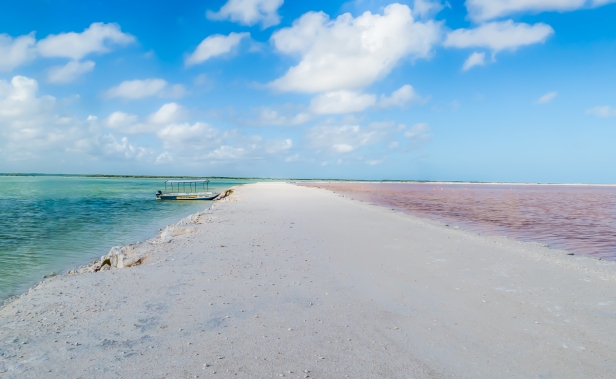
One more shot of flamingoes, because – flamingoes.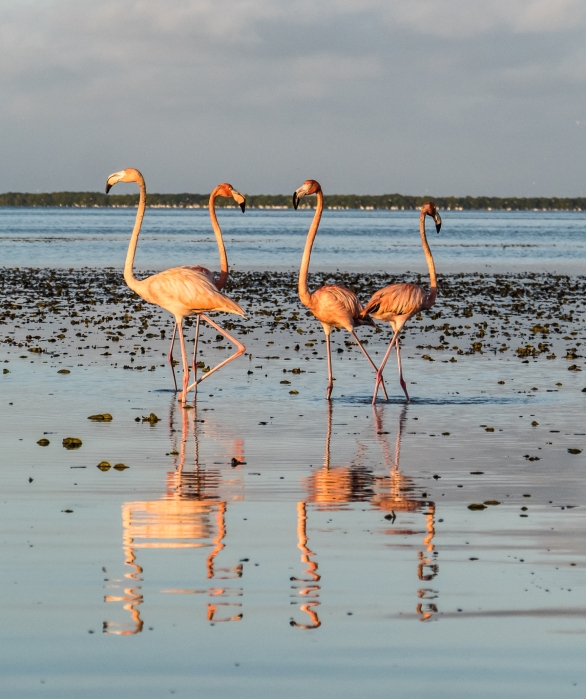
After three and a half hours, saturated with all we have seen, we arrive back in Rio Lagartos and eat a big breakfast at the restaurant above our room, sitting at a table overlooking the water. We are content right to our bones.
Next post: the city of Valladolid – pastel streets, crowds, blaring music, and some memorable meals.
Our tour of Ria Lagartos was with Ria Lagartos Adventures.
I’ve added an underwater video of our snorkelling trip to the Cozumel post.
All words and images by Alison Louise Armstrong unless otherwise noted
© Alison Louise Armstrong and Adventures in Wonderland – a pilgrimage of the heart, 2010-2016.

My God what a precious, thrilling experience you had there Alison! It was a pleasure for my eyes too! Great photos and text …as usual 😉 ❤
LikeLiked by 2 people
Thanks so much Pelly. It was an amazing experience!
Alison
LikeLiked by 1 person
HI Alison, Thanks for writing this lovely post. i love flamingos and all the shots are great. So do these guys fly off to Africa for hIlf the year ? Do you know?
Love the pelican shots as well. I watched quite a few flying around the beach in Adelaide over Christmas, they are graceful flyers for such a cumbersome bird. Australian pelicans have much more white on them.
The frigates are magnificent and I love the stilts with their long pink legs. Very chic with the black and white feathers. Love the boats at sunset.
Louise
LikeLiked by 2 people
Thanks Louise. I just read that 90% of all the world’s pink flamingoes migrate to Celestún and Ria Lagartos for breeding and nesting.
http://www.sfgate.com/mexico/mexicomix/article/Mexico-s-flamingo-flocks-dazzle-along-the-Gulf-2485830.php
I love watching pelis. I’ve often watched/photographed them down at the lake in Canberra, and seen them perching on the top of those big street lighting poles in Bateman’s Bay.
We saw many frigates in other parts of Mexico, and in Galapagos where the males all had their red balloon all puffed up – pretty spectacular.
Alison
LikeLike
Thanks for the link 🙂
LikeLiked by 2 people
You surely had a nice adventure with the birds. Such amazing photos Alison 🙂 Those pelican shots are wonderful.
LikeLiked by 2 people
Thanks so much Arlene. We had a great adventure!, and watching the pelis feeding right by the town promenade was really fun. They’re so determined, and comical.
Alison
LikeLiked by 1 person
Oh I don’t know where to start, the pelicans in flight are glorious, the reflected flamingoes are spectacular, the ruffled hunting heron, such a variety of brilliant captures! I love the line of boats. Marvelous Alison. You are so talented.
LikeLiked by 2 people
Thank you so much Cindy! What a time we had. Those pelis feeding, and then the sunset and the early morning light. It was wonderful for the experience, and for photography! Celestún was just the appetizer, Ria Lagartos was the full meal!
Alison
LikeLike
Alison, I love this post! For starters your photgraphs are magnificent! And…. Ben and I are avid bird watchers and will always seek out bird watching sites.
I first saw flamingoes by the hundreds in Namibia as a teenager.
Fairly recently we saw them in Cuba and then again very recently in Northern Sri Lanka. So amazing to see wildlife in natural habitat not being harmed or bothered by humans. We also were lucky enouhgh to visit a Frigate nesting island in Panama. Magical. Oh and lest I forget….the best experience ever – India where we opted for 3 days at a bird park in lieu of the Taj Mahal. Ha ha no regrets.
Love the photo of the birds taking flight and the flamingoes reflected in the water. Heck, I love ’em all.
Wonderful.
Peta
LikeLiked by 2 people
Thanks so much Peta. It must have been amazing to see great flocks of them as a teenager, but then I was seeing kangaroos and wallabies and echidna. I guess it’s just about where you grow up. Like you and Ben we love to be in nature, and love bird watching (the more exotic the better!) and these kinds of expeditions are our favourite. We saw many flamingoes in the high desert in Bolivia – that was amazing! We did the Taj *and* the bird park. I assume you’re talking about Bharatpur? We only spent a day there – the painted stork were nesting at the time – spectacular!
Alison
LikeLike
YES! Bharatpur. Thanks for reminding me of the name I could not remember it. We were supposed to be there for a day and continue on to the Taj, haha, but we elected to stay put and keep doing more of the same. Yes, the painted stork are spectacular there and we just recently saw them again here in Sri Lanka. Magnificent birds! Thanks for the older link… wonderful!!!
Peta
LikeLiked by 2 people
Alison, your bird photos are absolutely stunning. I particularly like the flamingoes “running on water” and the amazing flight formation you captured of the two frigate birds. My sister has been to Celestun and raved about it. It’s going on the list.
LikeLiked by 2 people
Thanks so much Caroline. I thought the graceful and elegant flamingoes quite comical the way the land – pulling their legs up so they look like they’re running. Those frigates were amazing! I was lying on the beach at the time, but I couldn’t believe they came so low! Re Celestún – don’t go on a tour from Merida like we did – the small amount of time on the water was ridiculous. I’d recommend staying in Celestún and seeing if you can arrange a boat privately to take you out early in the morning like we did at Rio Lagartos. April is the time to be in Ria Lagartos for the nesting I believe – this is when you’ll see thousands of them – apparently they all nest there spread out along the length of the estuary.
Alison
LikeLiked by 1 person
Thanks for the tips!
LikeLiked by 2 people
Great to see wild flamingos. I haven’t seen one outside a zoo or preserve here in Florida in many, many years!!
LikeLiked by 2 people
Thanks so much GP. It was pretty spectacular. We also saw them in Bolivia and Chile. They’re such amazing birds, and seeing them in the wild is really special.
Alison
LikeLiked by 1 person
Your pictures and narrative are always stunning and your adventure is inspiring. I may want to talk to you about how you do it. There will be big change in my life soon and I think I will be ready to travel endlessly but get boggled down by the logistics (or if there are any other than follow your heart). I wonder how I can travel without having a home country or is it just a matter of keeping my passport current? Peace, Harlon
LikeLiked by 2 people
Thank you so much Harlon for your lovely compliments. There are a lot of details that go into being nomadic, but it’s quite doable. I’ll fire off a short email to you so you’ll have my email address. Then when you’re ready you can ask as many questions as you like. Our destination choices are mainly governed by “follow your heart” and the weather. We started with a short bucket list, but the bucket never empties. The more we travel the more we find out about places we’d like to see. We have broad plans for up to a year ahead, but details are sorted as we go. We usually start each four to six month chunk with accommodation for the first 2 or 3 weeks booked and then make it up as we go along.
Alison
LikeLiked by 1 person
Thank you Alison for taking the time, and yes, I do have some for specific questions, which of course, I should be able to figure out from government resources, but these days it’s hard to find a good answer to a good questions. Peace, Harlon
LikeLiked by 2 people
Beautiful photos. And I love that sentence ‘we were content right to our bones’. Lovely.
LikeLiked by 2 people
Thanks Tracey. Content to our bones is exactly how we felt. It was a wonderful time.
Alison
LikeLike
I completely understand: “because — Flamingos”
LikeLiked by 2 people
Aren’t they fabulous?! I never get sick of watching them.
Alison
LikeLike
I guess it was before the time when you began visiting our place — I had a flamingo collection for about 20 years — everything, all round my house, hanging things, stuffies and wooden and ceramic and glass and fabric, everywhere sitting places, wrapped around things, mugs, dishes, wall stuff, you name it. My first handle online was PinkFlamingo, and even my educational-resources website was called PinkFlamingo’s URLs. And like you, I used to enjoy visiting flamingo places to see them for real. So I guess you’ve picked up the torch… LOL
LikeLiked by 2 people
Really nice pic
LikeLiked by 2 people
Thank you. Glad you like them.
Alison
LikeLike
Ya
LikeLiked by 1 person
Alison, I think you’re a bird whisperer. The variety of bird life you see and the photos you shoot are just amazing! I see birds in a whole new way thanks to your interest in portraying them as the magnificent creatures they are. The flamingos are exquisite. With such long legs and necks, they look kind of unbelievable in flight. Incredible post.
LikeLiked by 2 people
Wow, thanks Kelly. A bird whisperer eh?! It’s a challenge for me to photograph them, and I know photographers whose bird pics are soooooo much better so I’m always striving, although I will allow that they have better equipment which helps with sharpness. I love flamingoes, they’re so exotic and elegant. Getting them in flight was a bonus. They do look kinda funny in flight – great long necks and legs with these huge wings sticking out the sides.
Alison
LikeLike
Just passed by your blogs and caught those pics. So beautiful shots of birds. Just wonder…why….a crocodile there? 😀
LikeLiked by 2 people
Thank you so much. Crocodiles live there in the estuary – lots of them.
Alison
LikeLike
So enjoy your posts and pictures! Wonderful!!
LikeLiked by 2 people
Thanks so much Sherry. I’m so glad you’re enjoying the blog.
Alison
LikeLike
This post is awesome! The photography is breathtaking and your details are just superb! I must re-post… I want to have this post to look at on my rough days( I am bipolar and believe it or not the energy in the delicate serenity of nature helps me to stay calm)…I feel like I am right there! I will definitely be a frequent reader of your blog!
LikeLiked by 2 people
Thank you so much Wanda, I’m glad you enjoyed it, and that it helps keep you calm. That’s a huge compliment. And thank you for following, and all the likes!!
Alison
LikeLiked by 1 person
Reblogged this on Wanda D. Jefferson and commented:
The Adventures in Wonderland Blog is just amazing!
LikeLiked by 2 people
Thanks again Wanda. xo
LikeLiked by 1 person
Gorgeous Alison! Hope you are well! Just trying to get back on track after a very busy few weeks.
LikeLiked by 2 people
Thanks Nicole. We’re doing fine, enjoying Mexico. Hope you’re taking care of yourself!
Alison
LikeLiked by 1 person
Where in Mexico are you Alison? Do you do Instagram at all???? Would love to see more pictures. Yes I’m doing much better after my week in Costa Rica. I needed it so badly. So nice to get away and immerse myself in nature.
LikeLiked by 2 people
We’re currently in Palenque for the Inca ruins. We leave tomorrow for Villahermosa for only one day then we go to Chiapa de Corzo for 8 days for a local festival – all in the Yucatan Peninsula. I don’t have Instagram. Well I have an account but don’t use it. I can’t get into my account even though I’ve reset the password several times. I don’t have a smart phone so was using Don’s but never really got into it. Instagram and me is just a whole sad story. One day I’ll get my own phone and start doing it. Meanwhile I do post extra pics on Facebook. Are we friends on FB? We should be! Send me a friend request if you do FB.
https://www.facebook.com/alison.armstrong.923
Costa Rica sounds wonderful. We’re off to Guatemala at the end of the month – staying mostly at Lake Atitlan.
I know exactly what you mean about immersing yourself in nature.
Alison
LikeLike
Just sent a friend request Alison! Mexico sounds awesome and yes I’d LOVE LOVE to see all your photos. I don’t know much about that part of Mexico. Lake Atitlan has been a dream of mine. I’ve always wanted to go. Can’t wait to see your pics!
LikeLiked by 1 person
I love the line ‘We are content right to our bones.’ That was unbelievable Alison. Loved seeing the video and all those flamingoes simply astonishing. Flying no less! I’ve never seen that.
LikeLiked by 2 people
Thanks Sue. It was a pretty special experience. I’m so glad we went to Rio Lagartos as well as Celestún. I don’t think I’ve seen flamingoes flying before either. We saw plenty in South America, but I don’t remember seeing them flying.
Alison
LikeLiked by 1 person
Beautiful photos!
LikeLiked by 2 people
Thanks so much.
Alison
LikeLiked by 1 person
You’re welcome. 🙂
LikeLiked by 2 people
Beautiful images!
LikeLiked by 2 people
Thank you Jenn.
Alison
LikeLike
What a wonderful collection of bird photographs. I think the Night Heron is my favourite. We live near some salt lakes here in Spain and there are always many flamingos feeding in them. I am always fascinated by them.
LikeLiked by 2 people
Thanks Darlene. I’m still amazed the way the guide could spot the birds almost hidden in the mangroves. I loved the night heron too. It was just standing there, fishing maybe. And I never get tired of flamingoes! Maybe we’ll see you in Spain next summer 🙂
Alison
LikeLike
That would be cool!!
LikeLiked by 2 people
Flamingoes.
LikeLiked by 2 people
Yes! They are so wonderful!
Alison
LikeLike
How amazing and yes excitement… I have spent many holidays on the Yucatán peninsula and know the feeling… thankyou for showing me again in your beautiful post AND it’s lovely to get to know you here on WordPress x much love barbara x
LikeLiked by 2 people
Thank you so much Barbara, I’m glad you enjoyed this virtual visit back to the wonderful Yucatan. Lovely to meet you!
Alison xo
LikeLiked by 1 person
What a delightful collection of bird photos, Alison! Your wildlife photography is really stunning, and as a reader I can’t thank you enough for those brilliant shots. In my past travels, there were places where pretty, colorful birds abounded. Unfortunately, most of the time I didn’t have my camera ready, or my lens simply couldn’t handle the distance. But probably the biggest challenge was taking a decent bird photo in a dense forest! Maybe the next time you come to Indonesia I should take you to those places. You’re a bird whisperer anyway, as Kelly put it!
LikeLiked by 2 people
Thanks Bama. I must agree that taking bird photos in dense forest is very very difficult! Those darn leaves always get in the way! I will keep you to your promise – you can take us on some journeys in Indonesian forests and I’ll see if I do any better in the jungle. Probably not!
Alison
LikeLike
thank you for bringing me, Alison
to this most special place
reserved for most beautiful
big, and little birdies, david 🙂
LikeLiked by 2 people
Thank you for exploring
my contribution of beauty
of place and flying freedom.
Birds rule!
Alison
LikeLike
You are the very best at capturing birds! Every flamingo shot and those of the incredible pelicans had me rewinding the screen to look more closely. Of course, the others are pretty amazing, too. I hope someday that my husband and I can slow down enough to enjoy nature in this way. We do love the outdoors, but we are always being active, not just taking in what is on offer. Once again, you are an inspiration!
LikeLiked by 2 people
Thanks Lexie. I had good subjects, and a wonderful setting. The flamingos at sunrise were a true blessing. And the feeding frenzy of the pelis the evening before was endlessly entertaining. I like boat trips because you’ve no choice but to slow down.
Alsion
LikeLiked by 1 person
Some really amazing photos of birds.
LikeLiked by 2 people
Thanks rabirius. It was really a feast for me, especially the pelis and flamingoes.
Alison
LikeLiked by 1 person
Yes. I can see that. There are some amazing shots here.
LikeLiked by 1 person
We visited both Celestún and Rio Lagartos during our time in the Yucatan and I have to agree with you that Rio Lagartos was the much better journey through the reserve spotting the amazing variety of birds, crocodiles (which were so fascinating since this was the first time I’d ever seen them) and of course the gorgeous flamingos. Your photos were beautiful and I love how you caught the reflections and pink and coral tones. I can well understand both your excitement and the contentment “right to your bones!” Hope you enjoy Palenque (our first sighting of howler monkeys) and I can’t wait to hear what you think of Lake Atitlán. You are in for a real treat! Anita
LikeLiked by 2 people
Thanks so much Anita. Especially for Rio Lagartos I had some pretty wonderful light for photography. I’m glad we saw a croc but I must admit we’re a bit blasé about them now having seen so many in Australia, though I can imagine the excitement at seeing one for the first time. Loved Palenque, but we didn’t see any howler monkeys 😦
Tomorrow we’re off to a local festival in Chico de Corza. Should be fun.
Alison
LikeLike
Another great post, Alison. And I don’t care if they are crocs or gators, I don’t want to go in that river! Lucky you had a guide along. I really like the first photo of the flamingoes on land. But then the others after that are really cool, too. The pelican shots…whoa, the first one flying is sooo cool.
LikeLiked by 1 person
Thanks BF. There weren’t that many crocs, not like in Oz, but there was no way I was getting in that water either! I had so much fun watching and photographing the pelis fishing for dinner. The seagulls kept landing on their heads. I’d never seen that before. And the flamingoes were just spectacular. I could watch them for hours, and getting to photograph them at sunrise was really special.
Alison
LikeLiked by 1 person
yeah, crocs scare me. and you’re like becoming the bird whisperer…love the depth of field and color. flamingoes intrigue me, but they disappoint me in person, so ungainly…they look so much better in photos
LikeLiked by 1 person
I swoon over flamingoes – every time!
LikeLiked by 1 person
I get that! egrets do it for me for some reason!
LikeLiked by 1 person
Once again I am utterly amazed and awed by your ability to capture these birds. The one of the hummingbird is particularly stunning. And I love the picture of the young flamingo!
LikeLiked by 1 person
Thanks so much Felicity. The trick is having a very high shutter speed. That’s it pretty much, but photographing birds is always a challenge, and I discard more than I keep. That’s my first ever hummer on the move. They are soooo fast!
Alison
LikeLike
Resplendent. That’s the word that comes to mind.
One of my favorites is the opening photograph–the small bird who has commandeered that contraption floating in its landscape. I love the blue eye of the cormorant, the brilliant yellow eye of the heron, and the dark eyes of the hawk. I love the personalities of these various creatures.
And of course, the convention of pelicans. Looks more like a posse to me. 🙂
Peace
Michael
LikeLiked by 1 person
Thanks Michael. These trips, especially Ria Lagartos were such wonderful experiences for us. Nature resplendent! I’m always excited by the variety in nature – all birds, but all so unique. Who would think that a pelican and a flamingo belong to the same family? Resplendent indeed. I like your word posse. I think I will use it in future 🙂
Alison
LikeLiked by 1 person
We loved this post Alison. Your photographs are spectacular. We have to say that the lagoons, mangroves and salt flats of the Caribbean are amongst our favorite places. You captured the feeling and beauty of the birds so well. Thank you.
LikeLiked by 1 person
Thanks so much Tim and Anne. Both places are absolutely gorgeous, and of course it’s hard to ignore flamingoes! I’m so glad we went there. We haven’t had a lot of time in the Caribbean, but what we’ve seen has been wonderful.
Alison
LikeLiked by 1 person
Stunning photography …
LikeLiked by 1 person
Thank you so much.
Alison
LikeLiked by 1 person
Thank you for this fantastic accounting of the wildlife. We just got back from Celestun and saw many of the same birds. No crocodiles, though.
LikeLiked by 1 person
Thanks so much Maya. Celestún is pretty amazing isn’t it!
Alison
LikeLike